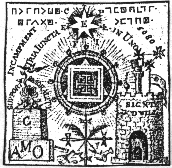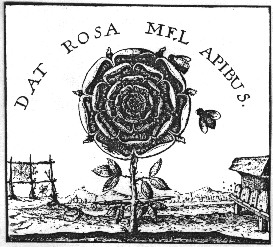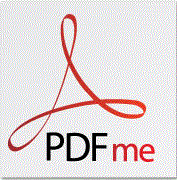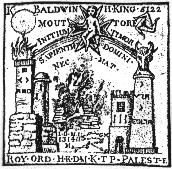
I reproduce here the final plate in a set of six copperplate engravings
found in the archives of a masonic lodge in Bamberg in Germany. These were
however of English origin, being engraved by P. Lambert R.A. and published
in London in 1789. This sixth plate from the series is especially rich in
symbolism and as much of which has obvious hermetic undertones it especially
attracted my interest. I am grateful to Joscelyn Godwin for bringing this
item to my attention. I am not a masonic scholar so am in no sense qualified
to analyse the symbolism from that standpoint, however, there are so many
hermetic resonances that I think it may be instructive to examine the
symbolic content from the hermetic viewpoint. At the very least we can see
how hermetic ideas were woven into the complex symbolism of late 18th
century Masonry in England.
This engraving shows an egg-shaped space set within a square frame, here
stylised into an architectural form. Around three sides of this square
setting is a message spelt out in the Royal Arch cipher or secret masonic
script. The key to this is given in the top left and right hand corners of
the square

Thus taking the angles of the relevant square C is
 , E (since it is dotted) is
, E (since it is dotted) is
 , F is
, F is
 , G (dotted) is
, G (dotted) is
 , and so on, K is
, and so on, K is
 , S is
, S is
 , while from the central square we see that B is
, while from the central square we see that B is
 , D is
, D is
 , and O is notated
, and O is notated
 . This particular arrangement of the letters is a blind however, and does
not decipher the text, but merely serves to illustrate the principle of the
cipher without giving away the secret message too easily. I have not taken
the time to work out the cipher, there being barely enough text to do a
letter frequency analysis, but there seem to be three separate encipherings
each section being separated by a key
. This particular arrangement of the letters is a blind however, and does
not decipher the text, but merely serves to illustrate the principle of the
cipher without giving away the secret message too easily. I have not taken
the time to work out the cipher, there being barely enough text to do a
letter frequency analysis, but there seem to be three separate encipherings
each section being separated by a key
 symbol. I understand, however, that the texts were decoded in an article in
Ars Quatuor Coronatorum, Vol III, 1890, pp. 36-37, though I have not
been able to consult this in preparing this article.
symbol. I understand, however, that the texts were decoded in an article in
Ars Quatuor Coronatorum, Vol III, 1890, pp. 36-37, though I have not
been able to consult this in preparing this article.
The lower side of the square has in English "Nothing without the V point and
the true Name of …", while below this on the plinth is written "This is to
certify that the Name of … is written in the Cubical Stone K". In the
circular radiance that appears from behind the square setting we have the
Latin phrase "If you can comprehend these things, you know enough", and in
the centre at the bottom of the plinth we have "Unless the Key is not
missing". Such teasing statements are of course found on early hermetic and
alchemical emblems, a well known example being Khunrath's Amphitheatre
Engravings which use similar phrases to taunt the reader, but this was a
common device in many earlier works. I understand that these particular
phrases are found inscribed on the regalia of a Companion of the Royal Arch.
Around the circumference of the oval space we find a much more
comprehensible statement:
Who teaches us to write and speak,
To speak in fair and soft terms,
To distinguish truth from falsehood,
To reckon and count all manners of numbers,
The mensuration of lines, superfices, solids,
The proportion, harmony and discords of sound,
The motion of luminaries, planets,
And how to measure their magnitude
and determine the distance of the Infinite.
[word(s) in cipher]
By the seven science of the 7 degrees of the Cubical Stone,
Whatever is, is right.
In the dark space within the oval, is placed:
No Kadosh No Heredom
No Heredom No Knights Templar
No Royal Arch No Knights Templar
No Symbols No Royal Arch
Linking to the statement at the centre bottom of the plate
"Unless the Key is not missing"
The central space is taken up by a pattern of eight squares bearing
elaborate symbolism. Two of these are shaded to appear as three dimensional
blocks rather than flat planes-the one on the left being the Brute Stone,
whilst that on the right is labelled the Cubical Stone. The six remaining
squares form a pattern, which can be wrapped up to form a cube.

The panel in the lower corner of the outer square shows the Mithraic
mysteries with a 'priest' celebrating at an altar formed from two flat
square stones and a cube. This image is also seen on one of the squares.
First we will consider the 'Brute Stone' and the 'Cubical Stone'. The
Cubical Stone shows the cosmic space of the planetary spheres and the realm
of the stars. On the earth stands Diana the 'Queen of Heaven' bearing seven
breasts. Four symbolic objects are shown-the square, compass, plumb-line and
scales, suggesting the geometric patterns of harmony that are found in the
cosmos. Beneath her feet is the 'Physical, Moral, Natural Philosopher's
Stone'. This picture echoes the symbolism of one of Robert Fludd's well
known diagrams.
Contrasting with this on the left side of the diagram is the Brute Stone.
Here a tree is seen upside down spanning the worlds, its roots in the Sun,
its branches spreading downwards through the realm of the Moon towards the
earth. Again this calls to mind another of Fludd's famous diagrams.

The Brute Stone also bears various masonic symbols - the pickaxe and broom,
the metronome or pendulum accurately beating time, while in the lower left
we see a mallet, square and level. This is the realm of the world bounded by
measurement (both of space and time). At the lower centre of this is a
temple with two pillars and central sanctuary and obelisk, suggesting that
the spiritual can be found in this world of measurement by the right
application of the cosmic spiritual principles of mensuration and
proportion. At the top centre of this stone is seen a cord with tassels set
across two rings. This implies a kind of veil or barrier between the cosmic
world of the planetary spheres and the outer physical world below, this gulf
being spanned by the inverted tree, the descent of the spiritual principles
from above as a living force, rather than abstract principles.
The six other squares form the surfaces of a cube when folded up, so we can
suggest that this is to be placed upon the Brute Stone, representing the
earthly world, and capped by the Cubical Stone, to form an altar of
aspiration. This altar thus contains in a coded form the essence of the work
of spiritualising the material world (the square between these two stones
has at its top centre a sketch of this altar). This set of six faces of the
cube seems to work especially with the symbolism of the Three, the Four and
the Seven.

Thus the lowest square has a triangular pyramid, a square tower of three
storeys (associated with Truth, Egality, Liberty - Hermes, Moses and
Solomon) and a seven runged ladder. There are also found other archetypal
symbols familiar in alchemy - the serpent, the double-headed eagle, the
skull and the tetramorph.

Architectural symbols are repeated on some of the other squares. Thus, the
second from bottom shows us the wall of a three-storeyed building, each
storey having three arched openings or niches. Below on the left a nonagon
bears nine letters possibly associated with these niches. Twin pillars,
another symbolic element common to this set of squares frame the triple
building, and (as we have noted earlier) in the central space above is the
archetypal form of an altar formed from a cube and two slabs of stone. This
has a triangle with nine letters set around it in cipher and from it
radiates out beams of light, and what appears to be a rainbow (also bearing
nine letters in cipher) forms an arc around the tower. In the small detail
of this square we find a menorah (seven-branched candlestick) and also a
chalice.

The third from bottom is a figure centred upon a radiant circular form set
upon a cross like stem. The radiant form bears a triangle and square at its
centre, while above flames a seven pointed star (labelled with an 'E'). To
the left is seen a square obelisk upon which is a a rose above which hovers
a dove. This is labelled 'support' and 'morality' while the plinth of the
obelisk has 'AMO' (Love). The round castellated tower to the right is the
'sign of God's Will'. Thus Love and Will are balanced. At the top of this
tower is a pillar with a book at its top and a lunar pennant or flag with
the image of the Moon. Three Templar crosses are set above. This figure
recalls the form of Robert Fludd's Rose on a Cross.

The square or face to the left is openly hermetic in conception centred on
the Caduceus or Mercury symbol. At its centre is an upward pointing triangle
and set on top a downward pointing triangle of flames, thus forming the Seal
of Solomon. This can also be seen as Sulphur, the radiating fire-principle.
At each corner of this square are seen geometrical figures, triangles,
square and circle, with numbers 1, 2, 3, 4 arranged so as to illustrate
mirror symmetries and reflections. Thus :-
4 3
1 2when mirrored become
3 4
2 1
The square on the right seems more directly masonic in symbolism. Four
towers are set in a rectangular arrangement. The square tower in the left
foreground set upon a rough built plinth and crowned with fire is partnered
by the obelisk on the right with a bull's head. In the background left is a
circular tower on a rough built plinth, while a castellated round tower is
placed in the background right. In the centre a figure seems to be offering
a sacrifice at a rough built altar while above the figure of a child is seen
in a Templar Cross. The masonic interpretation of this particular set of
symbols are not known to me.

The final square at the top of the oval space is an elaborate symbolic
statement of the operative use of this whole complex of symbolism of the
Cubic stone. A heptagon set in a circular space radiates outwards beams of
light, while around it is the statement familar in Rosicrucian circles 'In
Hoc Signo Vinces' - 'By this sign you are successful'. A priestly figure
crowned with the spirit (H.P. ='High Priest' ?) stands on a globe of the
world set in front of a six-columned temple. He extends his right hand
holding six stars while his left points to a triple headed dragon. Thus he
attempts to unite the above and the below-the realm of the cosmic spirit
with that of the inner dragon. To his right is a vessel burning incense
signifying the purification of the ritual space through air and fire.
Between his teeth he holds a dagger while upon his vestments is a seven
sided medallion with a 'K'.
|
![]()


















